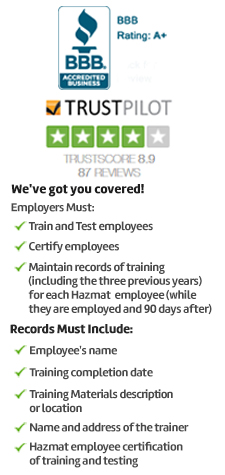
MSHA Part 48 Subpart B Surface Mining Initial Training

This course presents an overview of the requirements of the Mine Safety and Health Administration for the initial training of new surface miners. These MSHA requirements can be found in Title 30 Code of Federal Regulations (CFR) Part 48, Subpart B. The course covers some basic mining regulations for surface mines, as well as the recognition and avoidance of hazards at surface mines, emergency response procedures, and miners’ rights and responsibilities.
Governing regulations
This course presents an overview of the U.S. Department of Labor’s (DOL) Mine Safety and Health Administration (MSHA) New Miner Training for MSHA Part 48 training requirements. The mine operator must provide task and site-specific training in addition to the topics covered herein.
Every person at a mine site has a responsibility to ensure that health and safety standards are observed at all times. The employer is responsible for providing information, instruction, and supervision to all workers. The supervisor is responsible for ensuring that all workers are properly trained and are compliant with MSHA and OSHA regulations. And workers are responsible for observing all MSHA and OSHA standards and practicing safe work habits.
To be MSHA compliant your company must have a training plan that is approved by MSHA and administered by a competent person. Your company can use this or any of our courses as part of that plan.
If you are unsure how to write a training plan we can help with our Part 48 Underground Mining Training Plan course, the only one like it in the mining industry.
Course Overview
Welcome to the MSHA 30 CFR Part 48, Subpart B, Surface Mining New Miner Safety Training course. This course is designed to help you achieve a greater awareness of the health and safety hazards inherent in surface mining. The course aims to provide new miners with greater understanding of surface mine health and safety hazards, the regulations that accompany work at a mine, and the rights of miners.
Who Must Take this Course?
New miners and newly hired experienced miners must receive training BEFORE they begin work at the mine.
Course Format
Our MSHA Part 48 Subpart B Surface Mining initial training course consists of content, graphics, audio, self-check questions, and a final exam.
Upon successful completion each student will receive Hard copy of completion certificate and can print a wallet card
Continuing education credits?
Each student will receive 0.4 CEUs (or 4 CMEs) for completing this course.
Topics Covered
- About This Course
- Course Objectives
- Introduction to 30 CFR Part 48, Subpart B, Surface Mining New Miner Safety Training
- Federal Mine Safety and Health Act of 1977
- Key Terms
- 30 CFR Part 48, Subpart B Training Requirements
- Minimum Courses of Instruction
- Additional Training-New Tasks
- Additional Training-Annual Refresher
- Additional Training-Site-specific Hazard Awareness Training
- Recordkeeping and Training Compensation
- Miners’ Rights and Responsibilities
- Miners’ Rights-Overview
- Right to Protection Against Discrimination
- Protected Activities
- Reporting Discriminatory Conduct
- Right to Request an Inspection
- Making A Complaint
- Right to Be Represented or Participate in Inspections
- Procedures for Nominating a Representative
- Responsibilities of the Miners’ Representative
- Participating in Inspections
- Right to Pay During a Withdrawal Order
- Right to Be Informed of and Participate in Enforcement Proceedings
- Right to Receive Health and Safety Training
- 30 CFR 48 Training Rights
- Right to Health Protection
- Rights Relating to New and Revised Standards or Regulations
- Petitioning for Modifications to Safety Standards or Regulations
- Right to Information
- Responsibilities of Miners and Supervisors-Overview
- Miner Responsibilities
- Supervisor Responsibilities
- Line of Authority
- Introduction to the Work Environment
- Types of Surface Mines
- Strip Mining
- Open Pit Mining/li>
- Mountaintop Removal Mining
- Surface Mining Development
- Common Surface Mining Tasks
- Leveling
- Drilling
- Blasting
- Removing Overburden
- Dumping
- Backfilling
- Extracting
- Transporting
- Reclaiming
- Mine-specific Work Environment
- Transportation and Communication
- Transportation Hazards
- Blind Spots
- Blind Spot Accident Prevention
- Seatbelts
- Transportation of People
- Traffic Signs and Warning Signals
- Mine Communication
- Entering and Leaving the Mine
- Health and Safety
- Structural Hazards
- High Walls
- Walls and Benches
- Falls, Slips, and Trips
- Equipment Hazards
- Belt Conveyors
- Welding and Cutting Equipment
- Surface Powered Haulage Equipment
- Hand Tools-Slate Bars
- Hand Tools-Hammers
- Pinch Points
- Machinery Maintenance
- Equipment Inspections
- Equipment Repair Guidelines
- Fire and Explosion Hazards
- Fire Control and Prevention
- Explosives
- Storage of Explosive Material
- Electrical Hazards
- Electric Shock
- Arc Flash
- Burns
- Batteries
- Power Lines
- Additional Electrical Hazards
- Electrical Hazard Analysis
- Electrical Safety
- Lockout/Tagout (LOTO)
- Electrical Requirements at Surface Mines
- Atmospheric Hazards
- Oxygen-deficient Atmosphere
- Flammable Atmosphere
- Toxic Atmosphere
- Dust
- Dust Control
- Gases
- Gas Sampling
- Diesel Exhaust
- Respiratory Protection
- Health Effects of Atmospheric Hazards
- Black Lung
- Respiratory Protection Program
- Respiratory Protection Equipment
- Respirator Components
- Types of Respirators
- Physical Hazards
- Heat Stress
- Noise Exposure
- Noise Intensity and Maximum Daily Exposure
- Noise Exposure Levels
- Noise Exposure Troubleshooting
- Hearing Conservation Program
- Types of Hearing Protection
- Vibration
- Ergonomics
- Housekeeping and Sanitation
- Hazard Recognition and Avoidance
- Risk Assessment
- SLAM-Risk Management for Miners
- SMART-Risk Management for Operators
- Controls
- Engineering Controls
- Administrative Controls
- Personal Protective Equipment Controls
- Types of Personal Protective Equipment
- Surface Mine Inspections
- Hazard Reporting
- The Mine Act
- Dirty Dozen
- Hazard Communication Program
- Emergency Procedures and First Aid
- Emergency Response Plans
- Rescue Operations
- Self-Rescue Devices
- Mine Map
- First Aid
- Summary
- Additional Resources
- Exam

 NEBOSH CERTIFICATE
NEBOSH CERTIFICATE NEBOSH DIPLOMA
NEBOSH DIPLOMA IOSH
IOSH SAFETY DIPLOMA
SAFETY DIPLOMA CPD UK
CPD UK ROSPA UK
ROSPA UK FOOD SAFETY
FOOD SAFETY 



